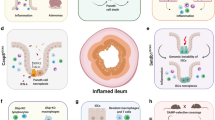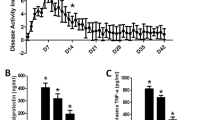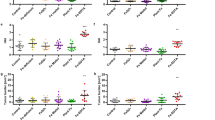Abstract
Animal models of intestinal inflammation are indispensable for our understanding of the pathogenesis of Crohn disease and ulcerative colitis, the two major forms of inflammatory bowel disease in humans. Here, we provide protocols for establishing murine 2,4,6-trinitro benzene sulfonic acid (TNBS)-, oxazolone- and both acute and chronic dextran sodium sulfate (DSS) colitis, the most widely used chemically induced models of intestinal inflammation. In the former two models, colitis is induced by intrarectal administration of the covalently reactive reagents TNBS/oxazolone, which are believed to induce a T-cell-mediated response against hapten-modified autologous proteins/luminal antigens. In the DSS model, mice are subjected several days to drinking water supplemented with DSS, which seems to be directly toxic to colonic epithelial cells of the basal crypts. The procedures for the hapten models of colitis and acute DSS colitis can be accomplished in about 2 weeks but the protocol for chronic DSS colitis takes about 2 months.
This is a preview of subscription content, access via your institution
Access options
Subscribe to this journal
Receive 12 print issues and online access
$259.00 per year
only $21.58 per issue
Buy this article
- Purchase on Springer Link
- Instant access to full article PDF
Prices may be subject to local taxes which are calculated during checkout


Similar content being viewed by others
References
Podolsky, D.K. Inflammatory bowel disease. N. Engl. J. Med. 347, 417–429 (2002).
Wirtz, S. & Neurath, M.F. Animal models of intestinal inflammation: new insights into the molecular pathogenesis and immunotherapy of inflammatory bowel disease. Int. J. Colorectal Dis. 15, 144–160 (2000).
Elson, C.O. et al. Experimental models of inflammatory bowel disease reveal innate, adaptive, and regulatory mechanisms of host dialogue with the microbiota. Immunol. Rev. 206, 260–276 (2005).
Neurath, M.F., Fuss, I., Kelsall, B.L., Stuber, E. & Strober, W. Antibodies to interleukin 12 abrogate established experimental colitis in mice. J. Exp. Med. 182, 1281–1290 (1995).
Neurath, M.F., Pettersson, S., Meyer zum Buschenfelde, K.H. & Strober, W. Local administration of antisense phosphorothioate oligonucleotides to the p65 subunit of NF-kappa B abrogates established experimental colitis in mice. Nat. Med. 2, 998–1004 (1996).
Dohi, T. et al. Hapten-induced colitis is associated with colonic patch hypertrophy and T helper cell 2-type responses. J. Exp. Med. 189, 1169–1180 (1999).
Ekstrom, G.M. Oxazolone-induced colitis in rats: effects of budesonide, cyclosporin A, and 5-aminosalicylic acid. Scand. J. Gastroenterol. 33, 174–179 (1998).
Boirivant, M., Fuss, I.J., Chu, A. & Strober, W. Oxazolone colitis: a murine model of T helper cell type 2 colitis treatable with antibodies to interleukin 4. J. Exp. Med. 188, 1929–1939 (1998).
Heller, F., Fuss, I.J., Nieuwenhuis, E.E., Blumberg, R.S. & Strober, W. Oxazolone colitis, a Th2 colitis model resembling ulcerative colitis, is mediated by IL-13-producing NK-T cells. Immunity 17, 629–638 (2002).
Iijima, H. et al. Specific regulation of T helper cell 1-mediated murine colitis by CEACAM1. J. Exp. Med. 199, 471–482 (2004).
Okayasu, I. et al. A novel method in the induction of reliable experimental acute and chronic ulcerative colitis in mice. Gastroenterology 98, 694–702 (1990).
Dieleman, L.A. et al. Dextran sulfate sodium-induced colitis occurs in severe combined immunodeficient mice. Gastroenterology 107, 1643–1652 (1994).
Tanaka, T. et al. A novel inflammation-related mouse colon carcinogenesis model induced by azoxymethane and dextran sodium sulfate. Cancer Sci. 94, 965–973 (2003).
Mahler, M. et al. Differential susceptibility of inbred mouse strains to dextran sulfate sodium-induced colitis. Am. J. Physiol. 274, G544–G551 (1998).
Becker, C. et al. In vivo imaging of colitis and colon cancer development in mice using high resolution chromoendoscopy. Gut 54, 950–954 (2005).
Wirtz, S., Becker, C., Blumberg, R., Galle, P.R. & Neurath, M.F. Treatment of T cell-dependent experimental colitis in SCID mice by local administration of an adenovirus expressing IL-18 antisense mRNA. J. Immunol. 168, 411–420 (2002).
Becker, C., Fantini, M.C. & Neurath, M.F. High resolution colonoscopy in live mice. Nat. Protocols 1, 2900–2907 (2006).
Kojouharoff, G. et al. Neutralization of tumour necrosis factor (TNF) but not of IL-1 reduces inflammation in chronic dextran sulphate sodium-induced colitis in mice. Clin. Exp. Immunol. 107, 353–358 (1997).
Rachmilewitz, D. et al. Immunostimulatory DNA ameliorates experimental and spontaneous murine colitis. Gastroenterology 122, 1428–1441 (2002).
Pfeiffer, C.J. & Qiu, B.S. Effects of chronic nitric oxide synthase inhibition on TNB-induced colitis in rats. J. Pharm. Pharmacol. 47, 827–832 (1995).
Author information
Authors and Affiliations
Corresponding author
Ethics declarations
Competing interests
The authors declare no competing financial interests.
Rights and permissions
About this article
Cite this article
Wirtz, S., Neufert, C., Weigmann, B. et al. Chemically induced mouse models of intestinal inflammation. Nat Protoc 2, 541–546 (2007). https://doi.org/10.1038/nprot.2007.41
Published:
Issue Date:
DOI: https://doi.org/10.1038/nprot.2007.41
This article is cited by
-
Targeting P2Y14R protects against necroptosis of intestinal epithelial cells through PKA/CREB/RIPK1 axis in ulcerative colitis
Nature Communications (2024)
-
Effect of minocycline, methyl prednisolone, or combination treatment on the colonic bacterial population in a state of colonic inflammation using the murine dextran sulfate sodium model
Microbial Cell Factories (2023)
-
Deubiquitinase OTUD6A in macrophages promotes intestinal inflammation and colitis via deubiquitination of NLRP3
Cell Death & Differentiation (2023)
-
Artificial-enzymes-armed Bifidobacterium longum probiotics for alleviating intestinal inflammation and microbiota dysbiosis
Nature Nanotechnology (2023)
-
Aptamer-Functionalized Microbubbles Targeted to P-selectin for Ultrasound Molecular Imaging of Murine Bowel Inflammation
Molecular Imaging and Biology (2023)
Comments
By submitting a comment you agree to abide by our Terms and Community Guidelines. If you find something abusive or that does not comply with our terms or guidelines please flag it as inappropriate.



